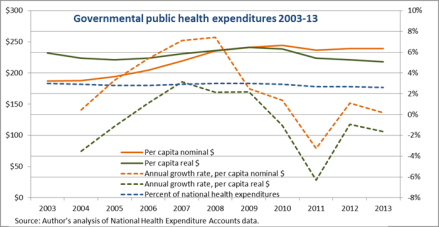Among the many joys of a new year are the refreshed and updated full-year estimates of national health spending from the federal government’s National Health Expenditure Accounts (NHEA). We now have the federal government’s official estimates of spending from calendar 2013, including the estimates of governmental public health spending that are of particular interest for readers of this blog. Unfortunately these data show a public health sector that has yet to recover from the recessionary contractions and austerity-minded fiscal responses of recent years (see figure).
Total governmental public health spending stood at $75.4 billion in 2013, nominally up from $74.8 billion the year before but still below the high water mark of $75.5 billion in 2010. Factoring in population growth, per-capita public health spending was $239 in 2013, several dollars short of the $241 per capita expended back in 2009. Overall U.S. health spending grew at a historically low rate of 3.9% in 2013, but despite this the share of spending devoted to public health declined to 2.6% from its recent peak of 3.0% in 2009.
When these data are adjusted for inflation, public health spending trends look even more grim. Using the NHEA’s new chain-weighted price deflator (check it out), we see that total inflation-adjusted public health spending actually declined by 1.1% in 2013, continuing the negative annual rate of growth observed since 2009. Per-capita public health spending stood at $218 in inflation-adjusted dollars – a full 10% below the level observed in 2009 and a 1.6% decline from 2012.
As I posted last year, we know there are many limitations inherent in the data sources and methods used to measure public health spending in the NHEA, and there are ongoing efforts to develop enhanced estimates (including our own). But an important strength of the NHEA data are their longitudinal consistency, allowing us to track year-to-year changes in public health spending with reasonable accuracy.
These trends reveal that public health resources have yet to recover from the Great Recession of 2008, and in fact these resources are still not even keeping pace with population growth and overall levels of price inflation. Although the economy is growing again, government revenues are recovering and medical care spending remains nicely in check, public health spending has not experienced a bounce-back. The health and economic consequences of this erosion of public health resources may not be immediate, but numerous studies tell us that these trends – if left unaddressed – will yield considerable human and monetary losses over time.
